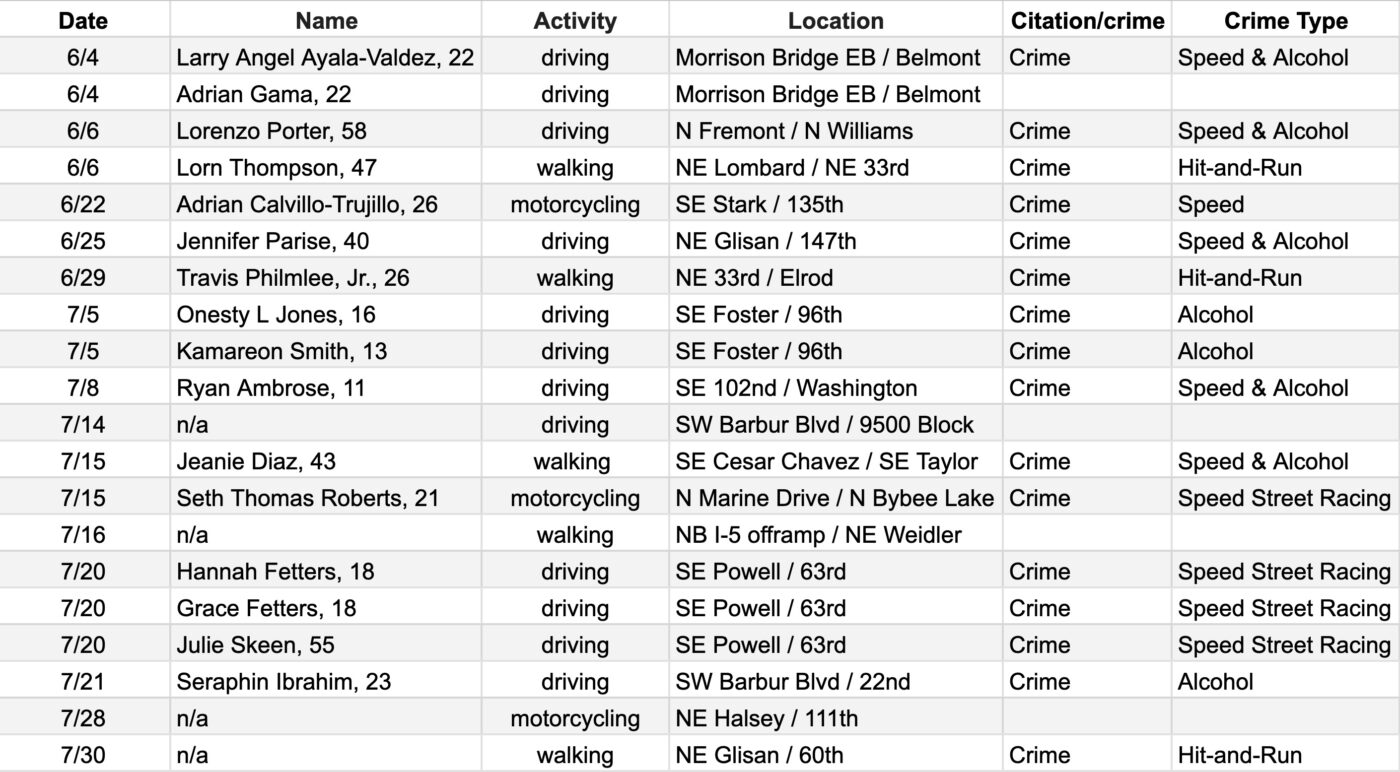I’ve been thinking a lot about the continuing toll of deaths, damage, and injuries from traffic crashes in Portland. Beyond the clear statistical rise in fatal crashes — including a confirmation I received this morning from the City of Portland that the 13 deaths on our streets in July were the most ever since at least 1993 — my spidey senses have been tingling for months as numerous people have posted about and/or messaged BikePortland about seeing or being involved in a serious crash.
And what’s with all the people who manage to flip their cars on relatively low-speed, neighborhood streets?
Bottom line is this: It’s very scary out there. People can feel it. And we’re on the precipice of a negative feedback loop where fewer people feel safe walking and biking, and more people feel safe driving fast, drunk, and without regard for others, which leads to fewer non-drivers using our streets, and so on.
Part of how I process my sadness and frustration about what’s going on is to analyze the crashes where someone dies. So far, I’ve been pouring over the list of 43 people who’ve been killed using our streets so far this year.
While in previous years alarms rang due to a rise is pedestrian fatalities, so far this year driving and motorcycling is where the most pain is being felt. Of the 43 fatalities, there have been 20 drivers and 8 motorcycle riders — about the same number of deaths from those modes we typically see in an entire year.
Here are a few other takeaways about where things stand:
A very violent summer on our streets
Of the 20 people who’ve been killed on Portland streets since the start of summer (June 4th to present), 16 of them died because someone committed a crime while driving. I haven’t done an exhaustive investigation into each crash, but from what I’ve read in Portland Police Bureau crash statements, there were: three hit-and-runs, 10 involved speed, eight involved alcohol, and at least five involved speed and alcohol.
Think about that for a moment. The fact that these behaviors are so rampant underlies the importance of taking a systemic, public health approach to our traffic safety crisis. Yes we need to fortify and defend our streets and public spaces from the scourge of these drivers, but I don’t want to live in a place where we are locked into an arms-race between vulnerable people and cars.
July was absolutely brutal. 13 deaths is the most in a one-month span for over 30 years. There were two multi-fatal crashes where five people died — and four of them were teenagers. Of the nine victims ages we know of, six of them were 21 years or younger. One of the victims in a separate crash was just 11 years old. And it wasn’t just Portland. The Washington County Sheriff’s office issued a special statement about the “particularly dangerous month.”
This should be an all-hands-on-deck moment
A story from Street Roots published Tuesday got it right by centering the leader of the Multnomah County Health Department’s disease prevention and health promotion unit. To get a handle on this epidemic of criminal driving behavior, poor choices, and the tragic consequences they lead to, we’ll need to zoom way out from the Portland Bureau of Transportation and the usual advocacy folks.
We need all-hands-on deck: local, county, regional, state, and federal agencies. And we need more than urban planners, traffic engineers and transportation advocates. We need health officials, law enforcement experts, community leaders, elected officials, and so on to engage and understand the urgency of what’s happening out there.
We need local leaders to step up. ASAP.
When two bicycle riders (and very nearly a third) were killed in two weeks in October 2007, a former Portland mayor called an emergency press conference and invite-only meeting with all the powerful players in city hall. After that event city council immediately coughed up $200,000 which was used for a new bike safety treatment called “bike boxes” (that have since become a PBOT toolbox mainstay).
Then again in June 2015, when several high-profile collisions involving vulnerable road users happened in short succession (including one man whose leg was ripped off by a driver on SE Powell and 26th), a Portland mayor and PBOT commissioner called another emergency meeting in City Hall. Less actionresulted from that one, but it still put the issue of safe streets squarely in front of Portlanders citywide.
What just happened in July must be met with an even stronger response. Despite nearly two decades of commitment to safe streets and 8 years into a “Vision Zero” pledge, we are on course for an all-time record number of deaths. I don’t care if people are dying on bikes, on foot, or in cars; dangerous streets and the selfish, unhealthy people who use them, are sucking the life out of our great city.
The time for plans and promises and pointing fingers has passed. Who will take substantive actions and give me something to write instead of just another op-ed? I’m waiting.
Note: Please keep in mind the number of cycling fatalities has (thankfully) remained very low. There have been zero biking deaths so far this year (knock on wood). And since 2018 we have averaged 2.6 per year. I think because BikePortland covers this issue so closely and tends to be a loud voice in traffic safety conversations, some folks assume incorrectly that bike deaths are spiking too. That is not what’s happening.




